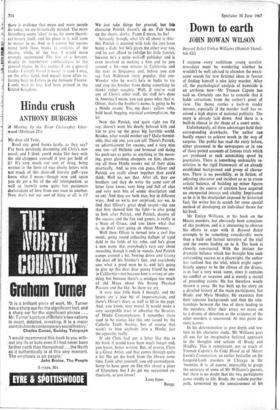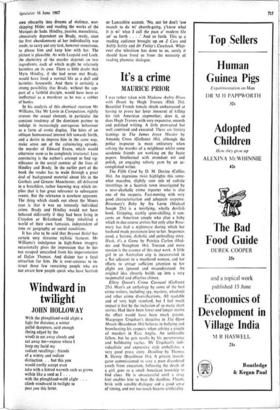Down to earth
JOHN ROWAN WILSON
I suppose every ambitious young novelist nowadays must be wondering whether he wouldn't be well advised to abandon the weari- some search for new fictional ideas in favour of finding himself a nice juicy murder. After all, the psychological analysis of homicide is an art-form now—Mr Truman Capote has said so. Certainly one has to concede that it holds attractions from the author's point of view. The theme carries a built-in reader interest, especially if the murder itself has re- ceived a high degree of national publicity. The story is already laid down. And there is a built-in climax in the shape of a court scene.
Unfortunately, all these advantages hold their corresponding drawbacks. The author can hardly expect to achieve much in the way of surprise. The public has read the story before, either piecemeal in the newspapers or in one of those potted accounts of famous trials which are produced at such astonishing speed by journalists. There is something undeniably re- strictive in the rigid, framework of an already established background and group of charac- ters. There is no possibility, as in fiction, of adjusting character and incident so as to create artistic balance, of building up minor figures which in the course of creation have acquired an unexpected interest and vitality. Imprisoned as he is in the straitjacket imposed by historical fact, the writer has to search for some special method of developing an individual theme for his book.
Mr Emlyn Williams, in his book on the Moors murders, has obviously been conscious of this problem, and it is interesting to observe his efforts to cope with it. Beyond Belief attempts to be something considerably more than a bald and factual narrative of the trial and the events leading up to it. The book is cleverly constructed. With the instinct for dramatic balance which has brought him such outstanding success as a playwright, the author has realised that the trial, which might super- ficially appear to be the climax of the drama, is in fact a very weak scene, since it contains no conflict or suspense and is merely a recital of preceding events. He has therefore wisely thrown it away. He has built up his story on a detailed history of the main participants, Ian Brady and Myra Hindley. He examines first their separate backgrounds and then the rela- tionships between the two of them leading to the murders. After their arrest we move on to a drama of detection as the evidence of the other murders is uncovered. At that point the story is over.
In his determination to give depth and tex- ture to his character study, Mr Williams goes all out for an imaginative fictional approach to the thoughts and actions of Brady and Hindley. This is reminiscent, not so much of Truman Capote's In Cold Blood as of Meyer Levin's Compulsion, an earlier bestseller on the Leopold-Loeb murders in Chicago in the 'twenties. It is, of course, impossible to gauge the accuracy of some of Mr Williams's guesses, but there is no doubt that the two participants come vividly to life. Brady, the sadistic psycho- path, tormented •by the consciousness of his own obscurity into dreams of violence, wor- shipping Hitler and reading the works of the Marquis de Sade. Hindley, passive, masochistic, obsessively dependent on Brady, ready, once the first abandonment of her individuality was made, to carry out any task, however monstrous, to please him and keep him with her. The picture is plausible. As with Leopold and Loeb, the chemistry of the murder depends on two ingredients, each of which might be relatively harmless on its own. There is little doubt that Myra Hindley, if she had never met Brady, would have lived a normal life as a dull and harmless housewife. And there is certainly a strong possibility that Brady, without the sup- port of a faithful disciple, would have been as ineffectual as a murderer as he was a robber of banks.
In his analysis of this chemical reaction Mr Williams, like Mr Levin in Compulsion, rightly stresses the sexual element, in particular the constant tendency of the dominant partner to indulge in increasingly outrageous behaviour as a form of erotic display. The hints of an oblique homosexual interest felt towards Smith, and a desire to impress him in the same way, make sense out of the culminating episode, the murder of Edward Evans, which would otherwise seem to be completely irrational. Less convincing is the author's attempt to find sig- nificance in the social context of the lives of Hindley and Brady. In the earlier part of the book the reader has to wade through a great deal of background material about life in the Gorbals and Greater Manchester, all delivered in a breathless, rather knowing way which im- plies that it has great relevance to subsequent events. But the relevance is nowhere apparent. The thing which stands out about the Moors case is that it was an intensely individual crime. Brady and Hindley would not have behaved differently if they had been living in Croydon or Birkenhead. They inhabited a world of their own fantasies, independent of time or geography or social conditions.
It has also to be said that Beyond Belief has certain very tiresome stylistic features. Mr Williams's indulgence in high-flown imagery occasionally gives the impression that he has not escaped unscathed from his impersonation of Dylan Thomas. And dialect has a fatal attraction for him. He is over-anxious to in- struct those few remaining people who are not aware how people speak who have Scottish
or Lancashire accents. 'No, uzz lot don't 'ave mooch to do wi' church-going, y'know what it is wi' what I call the pace o' modern life an' so forth . . . .' And so forth. This to a reading audience brought up on Z Cars and Softly Softly and Dr Finlay's Casebook. What- ever else television has done to us, surely it should have freed us from the necessity of reading phonetic dialogue.



































 Previous page
Previous page